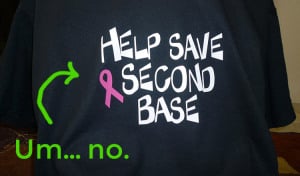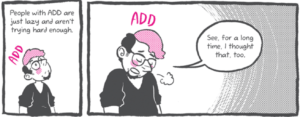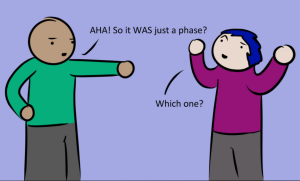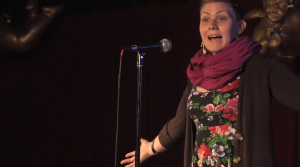
Credit: NSVRC
There is a parable used often in education to describe the reforms that are needed to better serve those students who are left behind or pushed out of our educational system:
A man and a woman were having a picnic along the river outside of their village. As they were eating, they heard a baby crying and, looking around for the source, saw a baby floating down the middle of the river.
The woman waded out and caught the baby and passed it to the man, only to realize there was another baby coming. The man ran to the village to get help, and before long, there was an organized party who were forming a chain across the river to stop the ever growing number of babies who were floating down the river. They saved a lot of children, but the number of babies was too many, and they could not save them all.
Then a young girl walked away from her duties on the riverbank and marched upstream. People yelled at her, “Where are you going!? We need your help!”
She replied, “I’m going to find who is throwing all these babies in the river so that we can stop them!”
Here’s the lesson for any social justice cause: If we don’t get to the root of the issue, all we’re doing is pulling some individuals to safety while losing others to the river.
In combatting sexual violence, undoubtedly, we must work to help survivors heal, seek justice, and find the “new normal” in their life, but that cannot be our only work.
We must prevent sexual violence before it happens. But how do we do that? What does it look like?
Expanding Who We Think of As Survivors
We can start by changing how we think about who experiences sexual assault.
In most prevention and response work, the focus tends to be on cisgender, straight women as victims and cisgender, straight men as perpetrators.
And there’s good reason for that: The vast majority of survivors are straight, cisgender women.
And with limited resources (especially in these times of austerity), those who work to prevent violence and support survivors tend to focus on that majority in order to best serve as many survivors as possible.
But to prevent sexual violence, we must acknowledge the incredible diversity of survivors and perpetrators.
For instance, when our conversations, advocacy, activism, and research focus so narrowly, we ignore the reality that sexual violence happens in 14% of lesbian relationships and 13% of gay relationships.
Further, 50% of transgender people experience sexual violence.
And considering that approximately 8% of all men (by conservative estimates) are raped by a former partner, to only talk about one form of sexual violence keeps us from best supporting all survivors.
And it keeps us from preventing sexual violence against those who don’t identify as straight, female, and cisgender.
Exposing the Perpetrators
But expanding the conversation about survivors still leaves us in the river, pulling babies from the water.
At some point, we must do more than address the needs of the diversity of survivors and begin identifying the causes.
And even in the world of professionals and activists who are committed to primary prevention, there are debates about what it looks like to prevent sexual violence.
But one thing we agree upon is this: We must know who is committing sexual violence in order to stop it.
Some activists argue that we need to focus with laser-like attention on repeat offenders so that we can root them out and “kick them off the island.”
And they’re right – to a point.
As Thomas MacAulay Millar brilliantly asserts on Yes Means Yes, we must focus on repeat offenders and on the culture that protects them.
After all, doing so would do well to prevent a tremendous number, even perhaps a majority, of sexual assaults.
But if there’s one thing I’ve learned in my years of sexual assault prevention and response work, it’s that our conversations must be nuanced.
Research suggests that perhaps 50% of sexual violence is committed by men who set out to commit sexual violence like that described in Millar’s analysis
But if we only focus on that 50% of sexual violence, we risk ignoring the myriad of other ways in which sexual violence can occur.
End Rape Culture
If we hope to end sexual violence in all of its forms, we must transform the culture around us that blames survivors, laughs at rape jokes, objectifies the bodies of human beings – most regularly women – and privileges perpetrators as more worthy of our legal and social protections than survivors.
In essence, we must end rape culture.
In his piece on Predator Theory, Thomas MacAulay Millar offers a fantastic place to start:
We need to adopt the stance that sexual interaction ought to always be had in a state of affirmative consent by all participants; that anything else is aberrant. If someone says, “I was sexually assaulted,” the first question should be, “why was a person continuing with sexual activity when zir partner did not want to?”
Real rape happens when the attacker is drunk and the target is drunker and alone and isolated . . . If we refuse to listen, he can continue to pretend that the rapist is some guy in the parking lot late at night, when it’s actually him, in our friends’ bedrooms half an hour after last call.
If we let that happen, we’re part of the problem.
Build a Culture of Consent
So if we end rape culture, what goes in its place? Well, the possibilities are endless as we begin to envision cultures of justice rather than of violence and oppression.
One place to start is with enthusiastic consent. As a young man, I was never taught what it means to include healthy, enthusiastic consent in my sexual relationships.
I was taught about condoms, but never about consent.
We need to teach better ethics of consent with fun and engaging tools, and in doing so, we need to dispel the myth that there is ever any sort of “gray area” in consent.
Transform Masculinity
Regardless of whether it happens in gay or straight relationships or is committed by cisgender or transgender people, make no mistake: sexual violence is a tool in a system of patriarchal oppression.
It is no accident that the vast majority of rapes are committed by men and that rape culture, by in large, supports violence against female-identified bodies.
A huge part of transforming rape culture means transforming masculinity.
Traditional constructions of masculinity value competition over cooperation, violence over non-violence, power over rather than power through and with.
To transform masculinity, men must begin to challenge the ways that we have been taught to be men, and we must work with other men to reconstruct masculinity.
For male-identified people, every relationship we have with other men needs to be one of transformation.
And though this must be men’s work, we need women-identified people to help us and hold us accountable along the way!
In short, it’s time for men to Rise.
Empower UPstanders
One of the most important steps that we can take to end rape culture and prevent sexual violence is to train and empower as many people as possible to act as UPstanders, rather than bystanders.
When people feel empowered to call out misogynistic language and behavior or to confront someone who they fear is perpetrating sexual violence or simply treating their partners’ with less respect than they deserve, our communities begin to change.
Our social norms begin to shift away from rape culture and toward safer, less violent, and healthier spaces for relationships and sexuality.
How do you do this?
The Green Dot program is a fantastic resource for giving people the tools to shift culture.
Or look through these guides from the Center for Disease Control and the Virginia Sexual and Domestic Violence Action Alliance. Both have lots of tools and best practices for empowering more people to act as UPstanders in our communities.
Root Out the 50%
Finally, we have to kick some people off the island.
In their 2002 study, Lisak & Miller added to a growing body of research that indicates that a significant percentage of sexual violence – perhaps 50% or 60% — is perpetrated by a tiny percentage of men.
These are men who use alcohol, manipulation, and overt physical violence or threats of violence (like twisting an arm or holding someone down) to rape.
These men rarely are exposed and even more rarely go on to face formal sanction or prosecution for their actions.
They hide in the cover of rape culture, knowing that few victims would ever speak out because of the hell they would face for doing so.
Thus, if we want to expose these perpetrators, we must start by believing and supporting survivors.
The more support survivors receive from their families, friends, communities, and institutions, the less cover perpetrators of sexual violence will have.
And the more survivors feel supported and believed, the more perpetrators will face social and legal sanctions.
Lastly, if you know someone who has or that you suspect has committed sexual violence, confront them!
Your relationship with that person will determine what that confrontation should look like, but if no one ever confronts them, perpetrators will never understand that others know about and loathe their actions.
It’s entirely possible that confronting rapists will not change their view that what they are doing is okay, but between the social pressure and fear of legal consequence, perpetrators will be less likely to commit these horrendous acts.
Aren’t sure how to confront a perpetrator? Here are a few suggestions:
- Know the person well? Try sitting them down for a conversation and telling them that you’re worried about how they treat their sexual partner(s).
- If you hear someone alluding to (or outright saying) that they want to get someone drunk so they can have sex with them, consider saying something like, “That is seriously pathetic. That’s the only way you can get with someone? Oh, and in case you didn’t know, it’s also called rape.”
- If you see someone you know using physical force to manipulate their partner or another person, say something. “Hey, hands off! It’s clear she/he/ze doesn’t want you touching them that way!”
- If someone makes a joke about their sexual conquests or about taking advantage of someone, express your discontent. “That’s disgusting. You seriously talk about women/men/people that way?”
- Appeal to their better nature (even if you’re not sure they have one). If you don’t like the way someone treats those they’re sexually involved with or interested in, statements like, “Come on. I know you know how to treat people better than that. Why do you insist on disrespecting/hurting him/her/zir?”
Obviously those are only the start to the conversation, but if we revoke perpetrators social license to operate, we prevent an incredible number of rapes.
Make Your Voice Heard
The fact that rape has long been illegal (despite some asinine laws still on the books), yet is so wildly common tells us that we cannot wait for systems of power to end sexual violence. We have to be the ones to transform our communities.
Want to discuss this further? Login to our online forum and start a post! If you’re not already registered as a forum user, please register first here.
Jamie Utt is a Contributing Writer at Everyday Feminism. Jamie is a diversity and inclusion consultant and sexual violence prevention educator based in Minneapolis, MN. He lives with his loving partner and his funtastic dog. He blogs weekly at Change from Within. Learn more about his work at his website here and follow him on Twitter @utt_jamie. Read his articles here and book him for speaking engagements here.
Search our 3000+ articles!
Read our articles about:
Our online racial justice training
Used by hundreds of universities, non-profits, and businesses.
Click to learn more




















